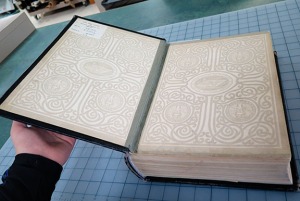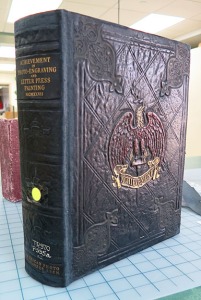One of my favorite challenges when doing full repairs is being able to save unique end sheets. My first experience with this did not look very clean and since I have always accepted the challenge to make it better. The end sheets for the Big Book were especially unique. They were made from a heavier, more brittle paper and decorated with using a pale olive and tan along with the saying, “your story in pictures leaves nothing untold.”
First, the halves of the end sheets that were pastedowns had to be lifted up from the board (starting from the inside) about one inch away from the center. Before the linen is applied to the text block, the free endpapers are cleaned (the cracking edges needed to be mended before any ‘saving’ could be done) and then hinged onto the text block. After the linen and liner have both been applied, PVA is placed along the inside joint of the case. The text block is then placed in the case and then into a press with rods along the outside joints.
After being in the press for about fifteen minutes, the book is then opened and the edges of the linen are placed under the lifted portion of the pastedown endpapers on both sides. If they are too large, they should be trimmed down to fit nicely when the book is closed. Finally the linen and the lifted endpaper are glued down with PVA and lightly pressed. To cover the portion of the linen still visible, tissue is applied along the inside joint. I’ve found it easier to fold the tissue in half, one half being twice as wide as the other, a 2:1 ratio. This way, when PVA is applied to smaller half it is easier to place it straight, with the folded edge fitting into the joint. Using a thin lifting bone folder, I press the tissue into the joint, gluing it onto the free endpaper. I can then use PVA the apply glue to the larger half and simply press this up and over the joint and onto the pastedown endpaper. I’ve found that this helps the tissue to become more manageable and lie in a straighter line and, ultimately, the saved end sheets look much nicer.
Finally, I was able to work on the outside of the book. The case of the Big Book was somewhat damaged, but not too bad. Using a mixture of PVA and Wheat Starch Paste (WSP) [2:1 respectively], I applied glue directly onto the damaged areas of the case. I then placed black tissue, pre-cut with frayed edges, over the corners, rims, joints and any other areas that needed a cover or reinforcement. I gently pressed the tissue into the case with my fingers, careful not to pull apart the tissue, and then added more of the glue onto the edges of the recently placed tissue. Using Remay scraps, I gently smoothed the fanned edges of the tissue outward, giving the repair a less noticeable look.
The Big Book allowed me to continue to adapt to the many ways we can approach problems here in the conservation lab. I’m always trying new things, such learning about the Oxford hollow and how to repair damage to the outside case, as well as refining older techniques, such as saving end sheets.



